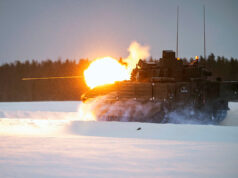In a change from its usual role, providing air defence to the Falkland Islands, the British Army’s 16th Regiment Royal Artillery have deployed to Estonia.
The deployment comes under NATO’s Trans-Atlantic Capability Enhancement and Training (TACET) initiative. The TACET initiative facilitates and enhances capability development, through the provision of subject matter expertise in agreed priority areas, between the Baltic States and Poland and the military units of 13 other countries including the USA, Germany and the UK.
As the only Short Range Air Defence regiment in the British forces, 16th Regiment Royal Artillery provides low-level Air Defence over the battlefield. Armed with the land based Rapier Air Defence system, it is responsible for defending essential resources such as airfields and bases. The Rapier system consists of a launcher with eight ready-to-fire missiles, a surveillance radar and tracker system.
Using their experience from conducting Air Defence and Air Surveillance operations around the world, the soldiers and airmen from 32 (Minden) Battery Royal Artillery and 49 (Inkerman) Battery Royal Artillery deployed to Estonia to help develop their host’s understanding of Ground Based Air Defence (GBAD), and exercise the effective Command and Control that is needed to conduct Airfield Defence operations.
Deploying as part of 140 Expeditionary Air Wing (EAW), which is in Estonia supporting NATO’s Baltic Air Policing mission, the Gunners quickly established a Base Defence Zone and started training exercises with the Estonian Air Force.
The Commanding Officer of 140 Expeditionary Air Wing, Wing Commander Gordon Melville said:
“NATO’s Baltic Air Policing Mission has been a fantastic opportunity to work alongside and integrate with our NATO allies, but also those aspects of our own forces within the wider defence community, allowing us to build on, and develop NATO’s collective capabilities”
Squadron Leader Andy Bates, Battery Commander of 49 (Inkerman) Battery said:
“Experienced in Airfield Defence from ongoing operations in the Falklands Islands, the Regiment is ideally placed to assist the Estonian Defence Forces in developing GBAD Tactics, Techniques and Procedures. Interoperability is vital, and training with other nations on deployments such as this improves everyone’s knowledge. Working with the Estonians has been a great experience.”
Colonel Jaak Tarien, Commander of the Estonian Air Force, visited 140 EAW and the GBAD deployment, adding:
“A Ground Based Air Defence system is high on the list of priorities for the Estonian Defence Force, and to be able to lean on the strength and experience of the UK in understanding the Command and Control challenges of such a system is extremely beneficial.”













Whenever I click on these articles they just go blank with a padlock in the corner and unable to read them, I have messaged the page owners but haven’t had a response yet. Anyone else had this problem or help?
No issues here
nope no issues here but try looking at your setting
Rapier / Sea Wolf / Harpoon what next Blood Hound to be re introduced ?
Distributed lethality and critical mass seem to be not on the agenda of the MOD or Armed forces Chiefs.
A national inquiry needs to be held into the destruction of the armed forces.
No probs either, on phone or laptop.
Phone mate
With the limited altitude of the rapier, means they can not hit the russian long range bombers, so seems just a PR move.
Anyone else see a problem with removing the only Short Range Air Defence regiment from the Falklands?
Argentina are in no position to attack the island and it is defended by typhoon’s anyway, which provde way better air defence anyway.